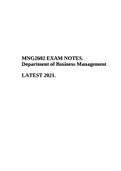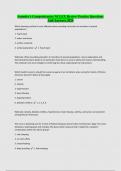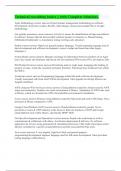MNG2602 EXAM NOTES.
Department of Business Management
LATEST 2021.
,Lynette Cronje
Primary lecturer for MNG2602 Department of Business Management
University of South Africa Email: cronjl@unisa.ac.za
UNIT 1
Features of contemporary organisations and new management challenges
Prescribed textbook chapter 3: pp 46–68
Study guide: pp 1–10
LEARNING OUTCOMES:
> Cite reasons why organisations change
> Identify “new” variables in the business environment of contemporary organisations
> Defend the statement that bureaucracy fails to provide for the needs of modern organisations
> Expound on the features of the new, emerging organisation
These changes in our lives can be attributed to two factors, namely:
globalisation; and
the Information Technology Revolution
Globalisation is the economic and social interaction process whereby different countries work together to
create a global economy. Globalisation involves technological, economic, political, and cultural exchanges
between different countries, and is the result of advances in communication, transportation, and infrastructure
(the Information Technology Revolution). The result of the process of globalisation is globality.
Students of business management should understand how globalisation, and major on- going advances in
technology, affect organisations and the way they do business. In this study unit, you will find out how
organisations had to change fundamentally in order to be able to function in the globalising world.
Work through Chapter 3 in the prescribed book.
1.3 KEY CONCEPTS
A bureaucracy is a system of administration marked by rules and regulations, red tape and proliferation.
Customer capital is the value of relationships that an organisation builds with its customers, ± reflected
in their loyalty to the organisation and/or its products.
Diversity is the state of being different.
Globalisation is the economic and social interaction process whereby different countries work together
to create a global economy.
A global organisation operates in many countries as an integrated unit.
A flat structure is an organisational structure with fewer levels of management.
Human capital is the health, knowledge, motivation, and skills of employees; the attainment of this is an
end in itself.
Intellectual capital is the collective knowledge (whether or not documented) of the individuals in an
organisation or society.
1
, An international organisation operates in many countries but keeps the operations in each country
separated.
The Information Technology Revolution is a term that describes the economic, social and technological
trends that occurred because of major technological advances in the world.
An open system is one that interacts with its environment.
Structural capital refers to the competitive intelligence, formulas, information systems, patents, policies,
processes, and so on, that result from the products or systems the organisation has created over time.
Synergy occurs when many elements or subsystems work together to create an outcome that is of
more value than the total of what the individual input is.
A system is a set of interrelated parts designed to achieve a singular purpose to stay in balance.
A system boundary separates a system from its environment.
1.4 INTRODUCTION
Organisations had to change fundamentally in order to be able to function in the global world. This is mainly
due to forces in the environment, which change the way in which organisations operate. Systems theory is the
basis from which we study organisations, how we manage them, and it refers to changes in the environment of
an organisation that cause changes in the organisation itself.
Systems theory implies that we view the organisation as a system consisting of value-adding parts that work
together to achieve a common goal and purpose. Systems theory focuses on the interaction between the parts
of a system. Instead of reducing a system, such as the solar system, into its parts or elements (e.g. sun, earth,
Venus), systems theory focuses on the relationships between the parts of the system, how they work together
as a whole and the interrelationship between them. The effect of the interrelationship between parts is that a
change in one part could cause a change in one of the other parts.
1.5 FORCES THAT CAUSE ORGANISATIONS TO CHANGE
Study the six change stimuli discussed in the prescribed textbook. Figure 1.1 contains a mind-map of the
textbook content pertaining to the six major forces for change in organisations. Feel free to add and change the
mind map according to your own understanding.
1.6 THE CLASSIC MODEL OF THE FORMAL ORGANISATION
In management literature, some authors state that major changes in the business environment during the past
two decades caused a ``new'' kind of organisation to emerge. In order to study the ``new'' organisation one
should understand the ``old'' organisation, its strengths and its weaknesses. The ``old'' organisation features
the characteristics of Weber's Bureaucracy. He developed this organisation model at the turn of the nineteenth
century. According to Weber's model, organisations should subscribe to several desirable characteristics, such
as:
division of labour
hierarchy of authority
rules and procedures
impersonality
employee selection and promotion
Table 1.1 lists the strengths and weaknesses of the bureaucracy
2
, 3






